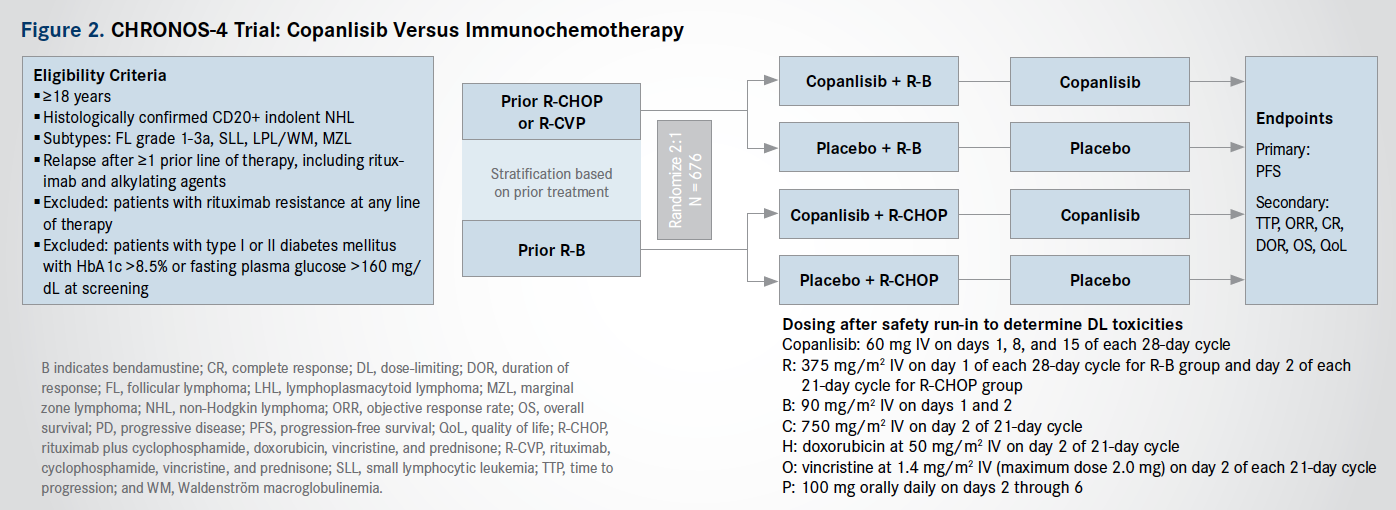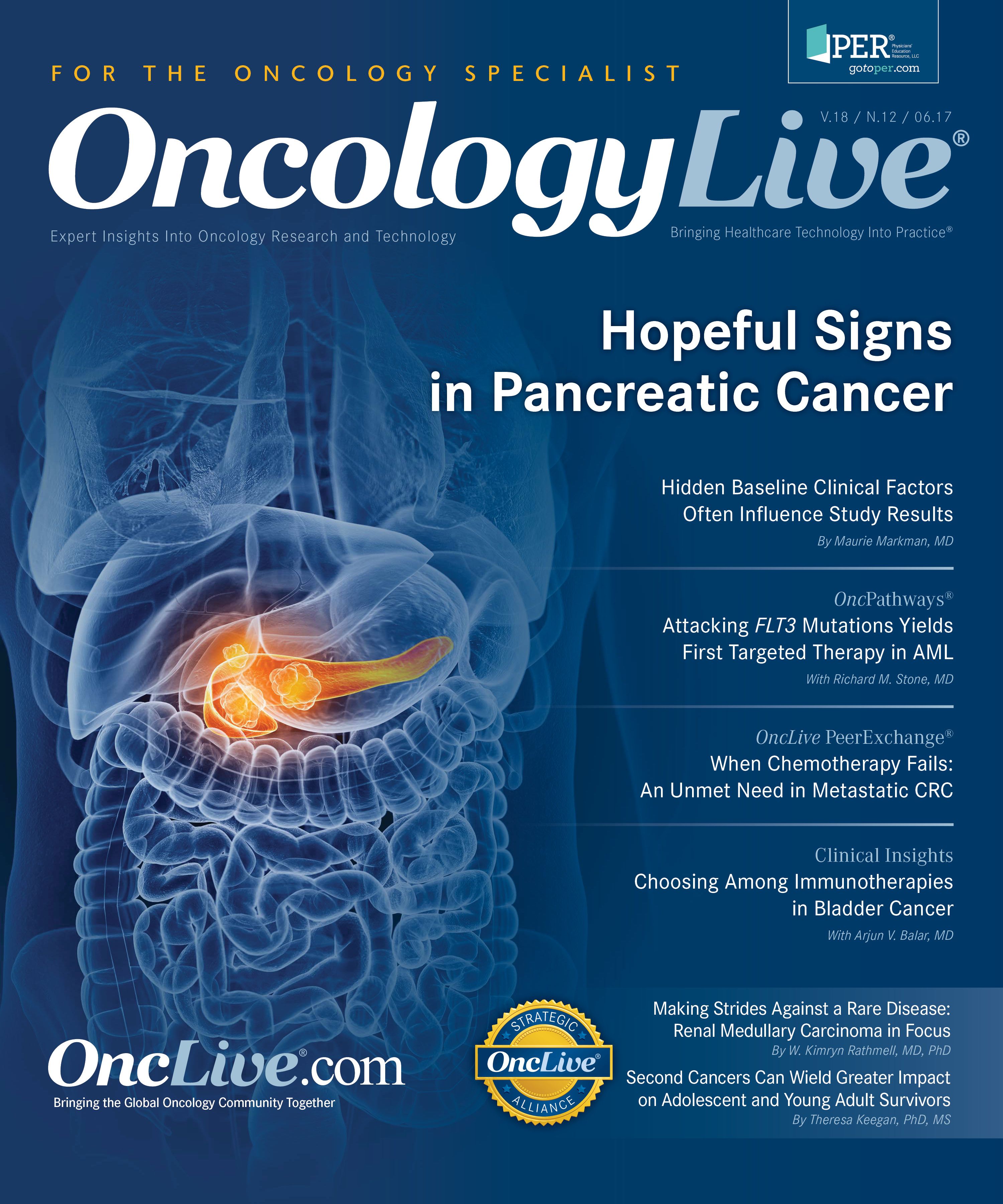Two Late-Stage Trials Test Novel PI3K Inhibitor in Non-Hodgkin Lymphoma
Copanlisib (BAY 80-6946), a novel PI3K inhibitor, is being combined with standard rituximab-based regimens in patients with relapsed, indolent non-Hodgkin lymphoma.
John F. Gerecitano, MD, PhD
Copanlisib (BAY 80-6946), a novel PI3K inhibitor, is being combined with standard rituximab (Rituxan)-based regimens in patients with relapsed, indolent non-Hodgkin lymphoma (NHL) in 2 phase III clinical trials that investigators hope will expand treatment options in refractory disease settings, particularly with less toxic alternatives.
The clinical trials are continuing while the FDA reviews a new drug application for copanlisib as a treatment for patients with relapsed/refractory follicular lymphoma (FL), which is among several subtypes of CD20-positive NHL included in the late-stage trials. FL is the most common subtype of indolent NHL, accounting for about 22% of newly diagnosed cases.1
The FDA agreed on May 17 to review the application based on earlier clinical trial data under its priority review program, in which the agency is scheduled to decide within 6 months versus the standard 10-month review, according to Bayer, which is developing the drug.
The CHRONOS-3 trial is comparing the combination of copanlisib plus rituximab with rituximab plus placebo in patients with relapsed indolent B-cell NHL (Figure 1). The CHRONOS-4 trial is evaluating copanlisib with either rituximab plus bendamustine (Treanda) or with R-CHOP (rituximab plus cyclophosphamide, doxorubicin, vincristine, and prednisone; Figure 2) in a similar patient population.

“The trials are designed to give clear data about what will improve upon standards for treatment in these patient populations,” said John F. Gerecitano, MD, PhD, who is the global co-principal investigator for both CHRONOS trials.
Although advances in immuno-chemotherapy have led to improvement in the prognosis for patients with NHL, relapsed and refractory disease is still a challenge to treat successfully. “These patients require lifelong intermittent therapies for their disease, since these are incurable diagnoses, and we’re trying to develop more targeted agents that will be less toxic than traditional cytotoxic chemotherapies,” said Gerecitano, clinical director of Outpatient Lymphoma Services at Memorial Sloan Kettering Cancer Center and assistant professor of medicine at Cornell Weill Medical College, both in New York City.

CHRONOS Trial Details
The PI3K pathway, which regulates proliferation and survival in various cell types, has emerged as a promising target for anticancer therapy, particularly in hematologic malignancies.2 Copanlisib is a highly selective and potent pan-class I PI3K inhibitor, preferentially active against the alpha and delta isoforms.2 PI3K-delta is expressed only in hematopoietic cells and has been shown to play a critical role in B-cell function, while expression of the alpha isoform is increased upon relapse and may be a factor in tumor escape mechanisms.2,3The CHRONOS-3 and CHRONOS-4 trials are both open to patients with the indolent NHL subtypes of FL grades 1 to 3a, small lymphocytic leukemia (SLL), lymphoplasmacytoid lymphoma (LHL)/ Waldenström macroglobulinemia (WM), and marginal zone lymphoma (MZL). Patients with a histologically confirmed diagnosis of FL grade 3b, disease transformation, or chronic lymphocytic leukemia are excluded.
In CHRONOS-3 trial (NCT02367040), investigators are seeking to determine whether copanlisib in combination with rituximab is superior to rituximab with placebo in patients who have relapsed after 1 or more prior lines of rituximab-containing therapy. An estimated 567 patients will be randomized in a 2:1 ratio to either the combination copanlisib and rituximab arm, or the rituximab and placebo arm.
The trial is enrolling patients with a histologically confirmed diagnosis of relapsed, CD20-positive indolent B-cell NHL and an Eastern Cooperative Oncology Group performance status less than or equal to 2. There can be no known lymphomatous involvement of the central nervous system. Patients cannot have documented evidence of resistance to prior treatment with idelalisib or other PI3K inhibitors.
Prior to treatment, blood samples will be collected for safety and pharmacokinetic analyses. Archival tumor tissue and blood samples will also be collected for biomarker analysis and central pathology review. The primary endpoint is progression- free survival (PFS); secondary endpoints are objective tumor response, duration of response (DOR), overall survival (OS), complete response, and time to disease progression. The investigators will also be assessing the safety and tolerability of the combination.
The CHRONOS-4 trial (NCT02626455) is investigating whether copanlisib in combination with standard immunochemotherapy is effective and safe compared with placebo in combination with standard immunochemotherapy.
An estimated 676 patients will be stratified into 2 groups based on prior treatment, with the first group consisting of patients who have previously received R-CHOP or R-CVP (rituximab plus cyclophosphamide, vincristine, and prednisone) and the second group made up of participants who have received rituximab plus bendamustine (R-B). Patients also will be stratified based on NHL histology (FL vs other indolent NHL), and duration of treatment-free interval (6-12 months vs >12 months).
Participants in the first group will then be randomized 1:1 to receive either copanlisib plus R-B or placebo plus R-B. Those in the second group will be randomized to either copanlisib plus R-CHOP or placebo plus R-CHOP.
The trial is open to patients who have relapsed after 1 or more prior lines of therapy, including those who have received rituximab and alkylating agents. Notably, patients who may have had previous exposure to PI3K inhibitors also are eligible, provided there is no documented resistance. There must also be no evidence of resistance to rituximab at any line of therapy.
Prior to the full phase III trial, there will be a safety run-in phase for CHRONOS-4 to assess a dose escalation for the chemotherapy combinations, according to Gerecitano. During this phase, copanlisib will be given at 45 mg or 60 mg in the R-CHOP arm on days 1 and 8 over a 21-day cycle, and in the R-B arm, copanlisib will be given on days 1, 8, and 15 over a 28-day cycle. For cycles 1 through 6, R-CHOP and R-B will be given at the standard doses for lymphoma for 6 cycles. After 6 cycles, copanlisib maintenance will be given on days 1, 8, and 15 of a 28-day cycle.
Prior Research Into Copanlisib
The primary endpoint of CHRONOS-4 also is PFS; secondary endpoints are objective tumor response, DOR, OS, complete response, time to tumor progression, and safety and tolerability.The new drug application for copanlisib is based primarily on findings from the phase II CHRONOS-1 trial, which included patients with multiple types of lymphoma. In the study, 59% of patients achieved objective responses to the intravenously administered copanlisib. Responses were durable, and the median PFS approached 1 year.4
Lymphoma subtypes included in the CHRONOS-1 study were FL grades 1-3a, MZL, SLL, and LHL/ WM. Eligible patients had relapsed or refractory disease and failure of at least 2 prior lines of therapy.
Data analysis included 142 patients who had a median age of 63. The median time since the most recent disease progression was 8.3 months, and the study population had received a median of 3 prior regimens. All patients had prior exposure to rituximab and 1 or more alkylating agents, and 60.6% had disease that was refractory to the last regimen received.
Across the lymphoma subgroups, 80.3% of the patients had advanced disease (stage III or IV) at enrollment. FL was the dominant lymphoma subtype, accounting for 73.2% of the study population.
The 59.2% overall response rate included complete responses in 12.0% of patients and partial responses in 47.2% of patients. An additional 29.6% of patients had stable disease, resulting in a disease control rate of 85.9%. Objective response rates were 59% or higher across all lymphoma subtypes except LHL/WM, wherein 1 of 6 patients with the subtype achieved an objective response with copanlisib.
The study population had a median PFS of 11.2 months (95% CI, 8.1-24.2). In the FL subgroup, the median PFS was also 11.2 months.
The most common adverse events (all grades) were hyperglycemia (48.6%), hypertension (28.9%), and decreased neutrophil count (24.6%). Grade 3 hyperglycemia occurred in 33.1% of patients and grade 4 in 7.0%. Grade 3 hypertension occurred in 22.5%. Grade 3 decreased neutrophil count occurred in 6.3% and grade 4 in 12.7% of the patients. The most common laboratory abnormalities were elevated liver enzymes, which was grade 1/2 in all but a few cases.
“Copanlisib demonstrated significant efficacy, and the safety profile was manageable and distinct, compared with that of oral PI3K inhibitors, possibly due to the intermittent schedule and intravenous route of administration,” said Martin Dreyling, MD, PhD, head of the lymphoma program at University Hospital—Grosshadern in Munich, Germany, who presented the data at the 2017 American Association for Cancer Research Annual Meeting in April.
Gerecitano said the intravenous route of administration with copanlisib offers an improved toxicity profile compared with orally administered PI3K inhibitors in its class. “Although, like other drugs in its class that inhibit the alpha isoform of PI3K, copanlisib does lead to hyperglycemia and hypertension, there is an advantage to giving this intravenously instead of orally,” he said. “Some of the oral PI3K-alpha inhibitors cause chronic hyperglycemia much like diabetes and chronic hypertension, but this agent causes just transient hyperglycemia and hypertension, which does not require diabetic-like treatment in most patients.”
Both phase III trials exclude patients with type I or II diabetes mellitus with HbA1c >8.5% or fasting plasma glucose >160 mg/dL at screening.
References
- National Comprehensive Cancer Network. NCCN Clinical Practice Guidelines in Oncology: B-cell Lymphomas Version 3.2017. www. nccn.org/professionals/physician_gls/pdf/b-cell.pdf. Updated March 27, 2017. Accessed May 26, 2017.
- Koehrer S, Burger JA. B-cell receptor signaling in chronic lymphocytic leukemia and other B-cell malignancies. Clin Adv Hematol Oncol. 2016;14(1):55-65
- Copanlisib clinical trials. www.chronostrials.com/#copanlisibtrials. Updated March 2017. Accessed May 26, 2017.
- Dreyling M, Santoro A, Mollica L, et al. Copanlisib in patients with relapsed or refractory indolent B-cell lymphoma: primary results of the pivotal CHRONOS-1 study. Presented at: 2017 AACR Annual Meeting; April 1-5, 2017; Washington, DC. Abstract CT149. www.abstractsonline. com/pp8/#!/4292/presentation/12355.




